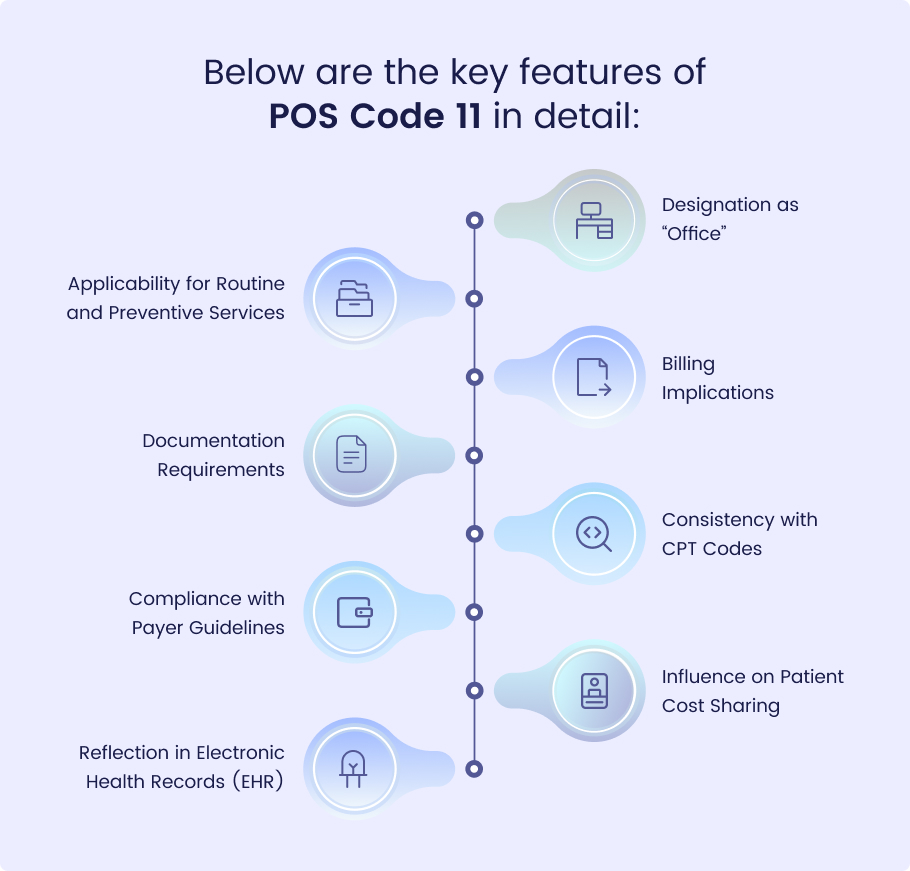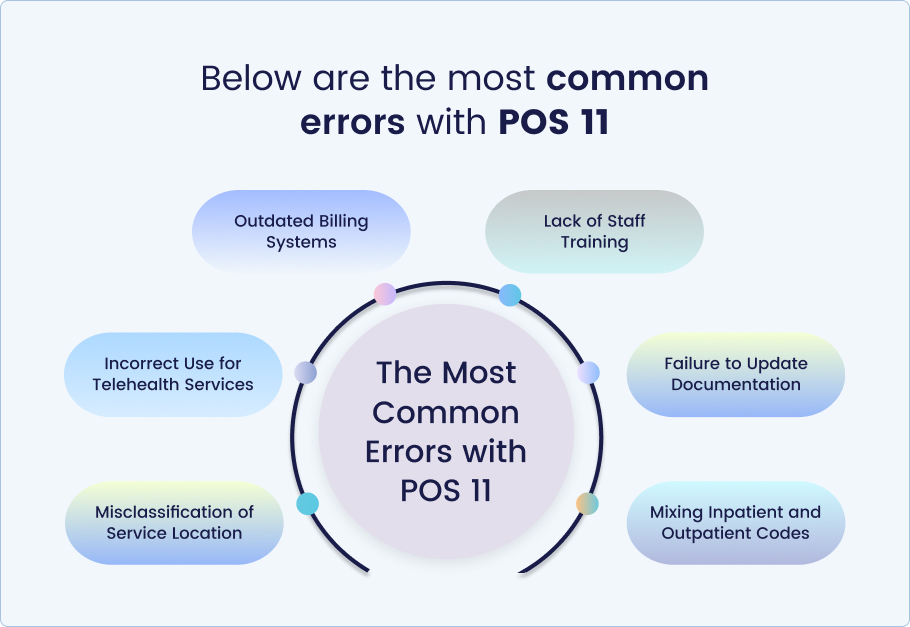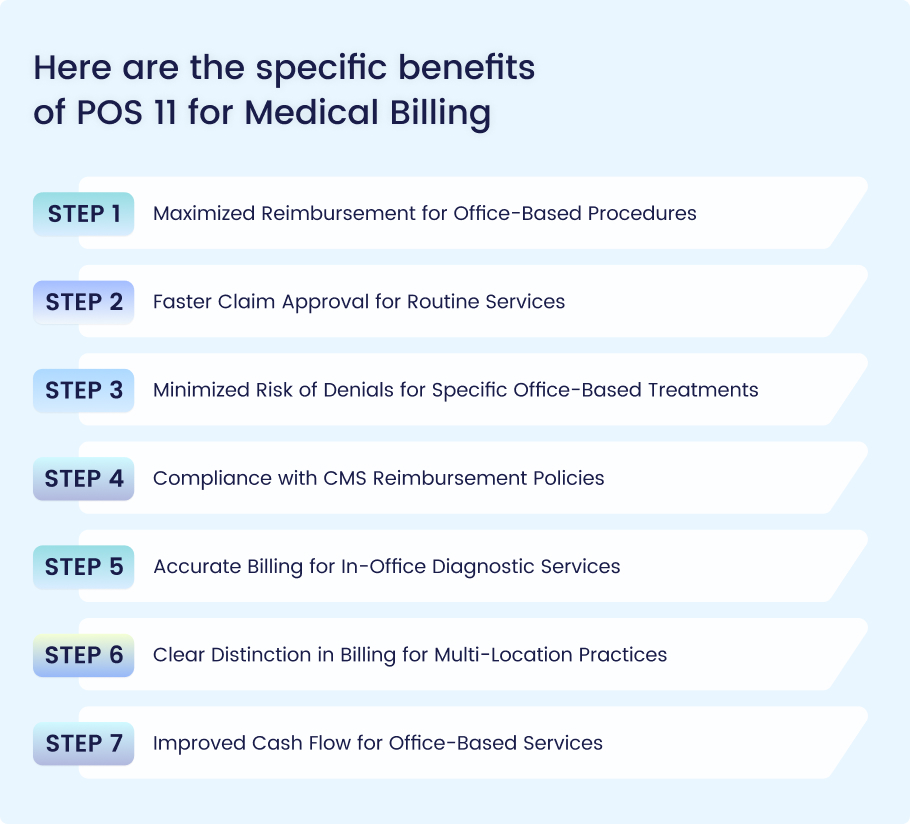
When it comes to healthcare or medical billing, there is hardly anything that is not significant—especially POS or Place of Service Codes. Of these, POS 11 is most relevant since it pertains to services delivered in a physician’s office.
Using POS 11 correctly is not just a simple coding exercise but an important and critical activity that has a direct influence on billing accuracy, reimbursement, and payer’s requirements. From the perspective of healthcare providers, understanding details involved in POS 11 is critical to the correct billing of office-based services and the overall efficiency of the practice’s financial processes.
In this blog, we focus on the details of POS 11, including the features, possible mistakes, and recommendations for your practice.
POS 11 in medical billing is a Place of Service code that represents a service that was delivered in a physician’s office. CMS employs this code as a means of indicating that the healthcare service delivered by the physician was in a setting that is usual and customary for providing care not involving a hospital or other healthcare setting. This code is crucial as it directly influences actual reimbursement rates.
POS 11 applies only to outpatient services and not inpatient or hospital services. This indicator is used to signify that the healthcare service was delivered at a physician’s office, which qualifies as an outpatient. Conversely, inpatient services usually occur in a hospital or other healthcare facility where the patient is admitted for an overnight stay or longer and constant supervision.
Specifically, when filing claims, it is important to correctly code POS 11 to show that the service has been delivered in an outpatient office setting. By applying this code erroneously, for example, for services delivered at inpatient care, the claims will be denied, paid less, or result in audits. Hence, to correctly manage medical billing, it is important to get acquainted with the distinction between inpatient and outpatient settings as well as different POS codes assigned thereto.
Below are the key features of POS Code 11 in detail:
Designation as “Office”
POS 11 is used to indicate that services were provided in a physician’s office. It relates to any healthcare services provided in a separate office environment and not in other facilities such as hospitals, outpatient amenities, and the like.
Applicability for Routine and Preventive Services
POS II refers usually to the consultations, checkups, prophylactic services, and any other administrative services that would be delivered in an office setting. This encompasses routine check-ups, revisits, and short office procedures, including annual physical examination follow-up visits.
Billing Implications
The use of POS 11 influences how services are charged and compensated. It normally corresponds with the compensation parameters and procedures for office-based services that can operate under different payment scales than outpatient or hospital services.
Documentation Requirements
Pertaining to POS 11, it is essential that documentation reflect that the service was rendered in the physician’s office. This could involve recording the specific office location and/or any additional information concerning the environment in the office where the service was delivered.
Consistency with CPT Codes
POS 11 can only be billed alongside CPT codes that relate to procedural services provided in an office environment. In order to obtain proper billing, it is better to choose CPT codes that relate to services provided in an office environment rather than others.
Compliance with Payer Guidelines
POS 11 may be used as per the rules and policies of various payers in different ways. To avoid the rejection of claims or delayed reimbursement, providers need to adhere to these payer-specific billing policies and guidelines that have been set.
Influence on Patient Cost Sharing
POS 11 affects the patient’s cost-sharing in some manner. It is important to note that the copayments or deductibles could differ between the services being rendered within an office environment compared to any other setting, making this a critical factor from the patient’s perspective.
Reflection in Electronic Health Records (EHR)
When working with POS 11, the EHR system must be properly coded and contain this setting to reflect it. It should state that the service was rendered in the office to avoid confusion when it comes to billing and documentation.
If these specific features of POS 11 are known, providers can avoid improper coding and billing or collecting inadequate reimbursement for the services they offer in an office.
There are specific mistakes with regard to the application of POS11 in medical billing, which can lead to problems like claim denials or improper reimbursement. Below are the most common errors:
Misclassification of Service Location
This occurs when POS 11 is incorrectly billed for services not rendered in a physician’s office but in a hospital outpatient department (POS 22) or an inpatient facility (POS 21). This misclassification often results in claim rejections.
Incorrect Use for Telehealth Services
Telehealth services have some special POS codes, such as POS 02 and POS 10. It is wrong to use POS 11 for these services, and this may lead to claim rejection.
Outdated Billing Systems
Billing software that is not in line with today’s POS code definitions will result in the wrong application of POS 11 and hence lead to wrong claims.
Lack of Staff Training
Lack of training can lead to misuse of POS 11 by staff who do not understand all the criteria, particularly when differentiating between services at various places.
Failure to Update Documentation
Failure to update the patient records to indicate the service was provided in an office implies that there could be problems when using POS 11 during audits.
Mixing Inpatient and Outpatient Codes
A lack of clear distinction between inpatient and outpatient status can lead to incorrect use of POS 11 in cases where services should be assigned to a different POS code, especially when a patient receives both outpatient and inpatient services.
Determine the Service Location:
Make sure that the service provided was in an office environment and not in a hospital or in a nursing home, for instance.
Accurate Documentation:
Documentation of the patient encounter is important. This includes pointing out the precise location where the service was delivered in order to avoid disputes.
Understand the Reimbursement Impact:
Since POS 11 often varies from other POS codes in terms of reimbursement, make sure that POS 11 is implemented correctly to show the right amount of payment.
Stay Updated with CMS Guidelines:
It is vigilantly important to keep up to date on the CMS guidelines and regulations to ensure non-billable services are correctly calculated.
POS 11 offers distinct advantages for medical billing when used correctly, particularly in optimizing reimbursement for services provided in a physician’s office. Here are the specific benefits:
Maximized Reimbursement for Office-Based Procedures
When it comes to general and minor procedures such as annual physical examinations, outpatient surgeries like excision of skin lesions like the mole, or follow-up visits performed in the physician’s office, the inclusion of POS 11 will help contain the charges for such services in physicians’ office settings. This is done to ensure that we receive high returns for these procedures and not the low facility-based reimbursements.
Faster Claim Approval for Routine Services
POS 11 is justified by payers for common, non-sophisticated treatments received in a physician’s office, including immunizations, diagnostic procedures like ECG, and preventive checks like Pap smears. This leads to quick approval of the claim because there is no question about the service location and the context in which the service will be delivered.
Minimized Risk of Denials for Specific Office-Based Treatments
Applying POS 11 correctly to particular treatments, such as allergen immunotherapy, physical therapy, or wound care administration in the office environment, helps to avoid denials. When billed under POS 11, these services meet the expectations of the payer, hence avoiding claims being pegged for review.
Compliance with CMS Reimbursement Policies
For office-administered treatments such as flu shots, in office lab tests (for example, blood glucose testing) and chronic disease management (for instance, hypertension monitoring), POS 11 enables practices to adhere to CMS policies concerning office-based services and facility-based services to achieve suitable levels of reimbursement.
Accurate Billing for In-Office Diagnostic Services
POS 11 enables physicians to effectively and accurately bill diagnostic procedures offered in a physician’s office, such as ultrasound, X-ray, and EKG. This accuracy ensures that these services are reimbursed at the correct rate, especially given that office-based diagnostic services are likely to have lower costs of operations than hospital-based services.
Clear Distinction in Billing for Multi-Location Practices
For practices that are run at multiple physical sites, POS 11 simplifies the differentiation of office-based services from those rendered in outpatient departments or surgical centers. For instance, a practice consisting of practice consultations that also include surgical procedures undertaken in a hospital setting may use POS 11 to avoid billing clients for consultations conducted in the office while charging the normal rate for those conducted in the hospital.
Improved Cash Flow for Office-Based Services
Since POS 11 is limited to services that take place in an office setting, such as shots like B12 injections and in-office procedures like skin biopsy, it means that claims are processed faster and reimbursement is expected in a faster and more predictable manner, therefore improving the cash flow.
Conclusion
To maintain the correct billing and reimbursement patterns of an office-based practice, it is very important to properly implement POS 11. This entails ensuring that documentation is accurate, the right CPT codes are employed, the provider is aware of the payer qualifications, and records are well kept to avoid any additional mistakes.
For practices intending to capture the best approach on how to bill and also for them to get it right, outsourcing to MedHeave Medical Billing Services should be considered as the best strategy. MedHeave has expertise in dealing with some tedious requirements of billing procedures, such as the correct utilization of POS codes like POS 11.
With MedHeave’s provision, healthcare providers centralize on the main task of maintaining patient satisfaction and health, knowing that all billing issues, including compliance, accuracy, and complications, are well handled. Choose MedHeave to handle your billing needs and experience the benefits of professional, reliable, and efficient medical billing services.













